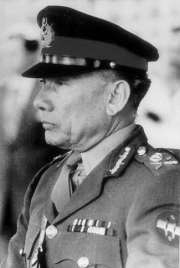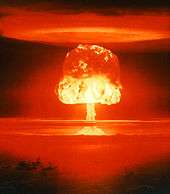Rahimuddin Khan
| Rahimuddin Khan رحیم الدین خان | |
|---|---|
 | |
| 7th Governor of Balochistan | |
|
In office 18 September 1978 – 22 March 1984 | |
| Preceded by | Khuda Buksh Marri |
| Succeeded by | Sardar F. S. Khan Lodi |
| 16th Governor of Sindh | |
|
In office 24 June 1988 – 11 September 1988 | |
| Preceded by | Ashraf W. Tabani |
| Succeeded by | Qadeeruddin Ahmed |
| Personal details | |
| Born |
21 July 1926 Qaimganj, United Provinces, British India (now India)[1] |
| Alma mater |
Jamia Millia Islamia Command and General Staff College |
| Religion | Islam |
| Awards |
|
| Military service | |
| Allegiance |
|
| Service/branch |
|
| Years of service | 1950 – 1988 |
| Rank |
|
| Unit | Baloch Regiment |
| Commands |
111 Brigade, Rawalpindi II Corps, Multan Ras Koh nuclear test sites 8th Army Infantry Division Chairman Joint Chiefs of Staff Committee |
| Battles/wars |
Lahore riots of 1953 Indo-Pakistani war of 1971 Balochistan conflict Soviet war in Afghanistan |
Rahimuddin Khan (Urdu: رحیم الدین خان; born 21 July 1926) is a retired four-star general of the Pakistan Army who served as Chairman of the Joint Chiefs of Staff Committee from 1984 to 1987, after serving as the 7th Governor of Balochistan from 1978 to 1984. He also served as the 16th Governor of Sindh in 1988.
As Balochistan's longest-serving governor, Rahimuddin ended the 1973 operation in Balochistan, declaring a general amnesty and military withdrawal in 1978.[2] His tenure saw widespread economic development and the halting of the Baloch insurgency,[3][4] but was controversial for suppressing the Afghan mujahideen entering the province during the Soviet war in Afghanistan.
Military service
Rahimuddin Khan was born in Qaimganj, United Provinces, India, in the majority Afridi Pashtun community that migrated from Khyber Pakhtunkhwa. He was the nephew of educationist Zakir Hussain, later the President of India, and the son-in-law of educationist Mahmud Hussain. He attended Jamia Millia Islamia University in Delhi, founded by Zakir Hussain. He opted for Pakistan during independence in 1947, enrolled as Gentleman Cadet-1 of the Pakistan Military Academy.[5] As captain, he helped enforce martial law in Lahore during the 1953 Lahore riots.
He attended Command and General Staff College at Fort Leavenworth, Kansas, and Command and Staff College in Quetta. He was hospitalized months before the Indo-Pakistani war of 1965 with a broken ankle. In 1969, he was appointed sub-martial law administrator to Hyderabad. He was Chief Instructor at the Armed Forces War College at the then National Defence College, Rawalpindi until 1975. According to Bhutto aide Maulana Kausar Niazi, Prime Minister Zulfikar Ali Bhutto wanted Rahimuddin to head the new Atomic Energy Commission and nuclear programme, but was declined.[6][7] As Lieutenant-General, he became Commander II Corps in Multan in 1976.[8] He was made Chairman Joint Chiefs of Staff Committee by General Zia-ul-Haq in 1984. He retired in 1987.
Judge of Mujibur Rahman's trial
In February 1971, Yahya Khan took Brigadier Rahimuddin off his 111 Brigade charge in Rawalpindi to preside over the military tribunal of Sheikh Mujibur Rahman in Faisalabad. According to Shuja Nawaz, Rahimuddin was reportedly uncomfortable conducting the trial.[9] He left mid-proceedings to command the brigade during the Indo-Pakistani war of 1971, but was recalled again by Yahya to award a verdict. Major General Iftikhar Janjua instead charged Naseerullah Babar with 111 Brigade. Following appeals from several officials in the United States Senate and House of Representatives, Yahya put Rahimuddin's unconfirmed sentence in abeyance.[10] Yahya's successor Bhutto rescinded the verdict. The court proceedings were never made public.
Governor of Balochistan
A military operation against separatists was commenced in Balochistan by Prime Minister Bhutto in 1973, claiming thousands of lives.[11] Rahimuddin was appointed Governor of Balochistan on September 16, 1978. He declared an end to the operation, and announced a general amnesty for fighters willing to give up arms. Army withdrawal was completed by 1979. The Baloch separatist movement came to a standstill.[12][13] Under Rahimuddin, Foreign Policy Centre held that "the province's tribal sardars were taken out of the pale of politics for the first time."[14] He was known for clean reputation during corrupt regimes.[15]
Development
Rahimuddin opened the Sui gas field to provide gas directly to Quetta and other Baloch towns for the first time. Electricity expansion from Quetta to Loralai converted vast areas with sub-soil water into fertile ones.[16] He also consolidated the then-contentious integration of Gwadar into Balochistan, notified as a district in 1977. Despite opposition from finance minister Ghulam Ishaq Khan, Rahimuddin heavily promoted large-scale manufacturing and investment in infrastructure, leading to provincial GDP growth rising to the highest in Balochistan's history.[17] Addressing the province's literacy rate, the lowest in the country,[18] he administered the freeing up of resources towards education, created girls' incentive programs, and had several girls' schools built in Dera Bugti District. He also oversaw the construction of nuclear test sites in Chaghai where tests were conducted in 1998.
Containment of Afghan refugees
During the Soviet war in Afghanistan, the Zia regime began aiding the anti-communist Afghan mujahideen. Millions of Afghan refugees, believed to be the largest refugee population in the world,[19] crossed over the border into Balochistan and Khyber-Pakhtunkhwa.[20] Under Zia and General Fazle Haq in KP, heroin and weaponry freely entered with the mujahideen.[21][22] In Balochistan however, Rahimuddin Khan detained the mujahideen in barbed wire military camps and seized their arms. Several fighters were allegedly transported back into Afghanistan by force, criticized by Pakistani human rights agencies. He also restricted refugees to civilian encampments during the war.[23] Pakistan's Balochistan policy became highly unpopular in the eyes of Afghans, but drugs and weapons remained low in the province, becoming widespread in Khyber-Pakhtunkhwa.[24]
Al-Zulfikar hijacking
In March 1981, the Al-Zulfikar terrorist organization led by Murtaza Bhutto hijacked a Pakistan International Airlines airplane from Karachi to Kabul.[25] The hijackers threatened to murder hostages if state authorities did not release specific political prisoners. Upon the authorities' refusal, Al-Zulfikar shot and killed passenger Captain Tariq Rahim, mistakenly believed to be the son of General Rahimuddin Khan.[15][26] The decision to kill Rahim was taken after Murtaza Bhutto consulted KHAD chief Mohammad Najibullah.[27][28] Tariq Rahim had actually been a former aide-de-camp to the elder Bhutto.[29] The episode was ended when Zia-ul-Haq released the prisoners.
Governor of Sindh and retirement
Zia dismissed his own government in May 1988. Rahimuddin became civilian Governor of Sindh, and governor's rule was imposed citing emergency.[30] Claiming corruption, Rahimuddin began dismissing large numbers of police and civil servants, including Z.A. Nizami from the Karachi Development Authority.[31][32] Rahimuddin also launched a brutal police crackdown on land mafia, one of the widest ever in Karachi, criticized by both PPP and the Zia regime for its heavyhanded tactics. It was stopped by the government immediately after he resigned. He moved to create separate police forces for the city and the rural areas, but this was also resisted after his resignation for fears of complicating the Sindhi-Muhajir relationship.[33] Special riot control officers were trained to cope with ethnic riots, and river and forest police were also set up to battle dacoity.[34] Ghulam Ishaq Khan became acting President after Zia's death in an aircrash on 17 August, and reintroduced the Chief Minister of Sindh office. Rahimuddin resigned in response, some say as this was attempt to limit his gubernatorial powers.[35] Post-retirement, he projected his chiefs of staff Asif Nawaz and Waheed Kakar for army chief.
See also
References
- ↑ Hindus Contribution Towards Making Of Pakistan 22 May 2010 Retrieved 28 January 2011
- ↑ "Historical sequence in Balochistan". DAWN. Inpaper. 16 December 2012. Retrieved 28 August 2015.
- ↑ Balochis of Pakistan: On the Margins of History. United Kingdom: Foreign Policy Centre. 2006. p. 75. ISBN 978-1-905833-08-5.
- ↑ "Tribal Politics in Balochistan 1947-1990" Conclusion (1990) p.6
- ↑ Bavadam, Lyla Bavadam (2008). "Brothers in arms". Retrieved 2009-05-27.
The cadets who left for Pakistan formed the First Course of the PMA. Gentleman Cadet No. 391 at the IMA, who became Cadet No. 1 at the PMA, and also honer of P.A(Pakistan Army) No 1, Rahim Uddin Khan, rose to the rank of General and became Joint Chief of Staff in Pakistan and, later, Governor of one of the provinces.
- ↑ Maulana Kausar Niazi The Last Days of Premier Bhutto p.60
- ↑ Maulana Kausar Niazi The Last Days of Premier Bhutto p.61
- ↑ Arif, Working with Zia, (1995), p.311
- ↑ Shuja Nawaz (2007) "Crossed Swords: Pakistan, its Army and the Wars Within"
- ↑ Matinuddin, Kamal Matinuddin (1994) "Tragedy of Errors: East Pakistan Crisis 1968-1971"
- ↑ Marri, Balach Marri (2002). "A History of Oppression". Retrieved 2002-08-14.
Mr Bhutto didn’t wait long and ordered the army to move in to the interior of Balochistan and then dismissed the Governments both in Khyber-Pakhtunkhwa and Balochistan...thousands of people were killed in those army operations, which continued for 5 years. Thousands were rendered homeless...
- ↑ Foreign Policy Centre, "On the Margins of History", (2008), p.36
- ↑ "Newsline: A History of the Baloch Separatist Movement". Iaoj.wordpress.com. 2009-06-17. Retrieved 2011-03-27.
- ↑ Foreign Policy Centre "On the Margins of History" p. 30
- 1 2 "Balochistan's history- Baloch Unity Organization". Balochunity.org. Retrieved 2011-03-27.
- ↑ "Tribal Politics in Balochistan 1947-1990" Conclusion (1990) p.8
- ↑ World Bank - Balochistan Economic Report 2009
- ↑ Daily Times (2007). "Balochistan home to lowest-literacy rate population in Pakistan". Retrieved 2009-01-05.
Balochistan is home to the largest number of school buildings that are falling apart. It also has the least number of educational institutions, the lowest literacy rate among both males and females.
- ↑ Amnesty International file on Afghanistan URL Accessed March 22, 2006
- ↑ The Afghan War Settlement
- ↑ "1982-1989: Fazle Haq Profile". Historycommons.org. 1999-02-22. Retrieved 2011-03-27.
- ↑ Kepel, Jihad, (2002), p.143-4
- ↑ bo shan (2008-07-29). "Bo Shan: "Human-proof fencing"". Knol.google.com. Retrieved 2011-03-27.
- ↑ "9/11 Truths: Clarification from Scott regarding Fazle Haq". 911truth.org. Retrieved 2011-03-27.
- ↑ 9/11 START| Terrorist Organization Profile: Al-Zulfikar Archived June 6, 2010, at the Wayback Machine.
- ↑ Anwar, The Terrorist Prince, (1997), p.121
- ↑ Anwar, The Terrorist Prince, (1997), p.106
- ↑ Anwar, The Terrorist Prince, (1997), p.123
- ↑ "Islamic Terrorism Timeline". Prophet of Doom. Retrieved 2011-03-27.
- ↑ "The Far East and Central Asia" (2003) Regional Surveys of the World p. 1166
- ↑ Ardeshir Cowasjee (13 February 2005). "Karachi's Woes". Dawn.
For years Karachi was at the mercy of a plunderer of the KDA, Z A Nizami, until one fine day the then governor of Sindh, General Rahimuddin, realizing that enough was enough, sacked the man...
- ↑ Ardeshir Cowasjee (2005). "Who can say? What?". Archived from the original on 2007-12-15. Retrieved 2007-12-28.
The Bishop persisted. In July 1988, he asked Governor Rahimuddin for the plot, categorically stating that he did not intend to construct a building thereon but would use it as an open playground. The authorities held their ground.
- ↑ "Near East and South Asia- U.S. Department of Commerce (1999) p.35" (PDF). Retrieved 2011-03-27.
- ↑ "Near East and South Asia- U.S. Department of Commerce (1999) p.36" (PDF). Retrieved 2011-03-27.
- ↑ Najam, Adil Najam (2006). "Ghulam Ishaq Khan Dead". Retrieved 2006-10-27.
Khan’s presidency also saw the resignation of General Rahimuddin Khan from the post of Governor of Sindh, due to differences between the two after Khan started restricting Rahimuddin’s vast amount of legislative power.
| Political offices | ||
|---|---|---|
| Preceded by Justice Khuda Bakhsh Marri |
Governor of Balochistan 1978–1984 |
Succeeded by Lt. Gen. Sardar F.S. Khan Lodi |
| Preceded by Ashraf W. Tabani |
Governor of Sindh 1988 |
Succeeded by Qadeeruddin Ahmed |
| Military offices | ||
| Preceded by Gen. Iqbal Khan |
Chairman Joint Chiefs of Staff Committee 1984–1987 |
Succeeded by Gen. Akhtar Abdur Rahman |
